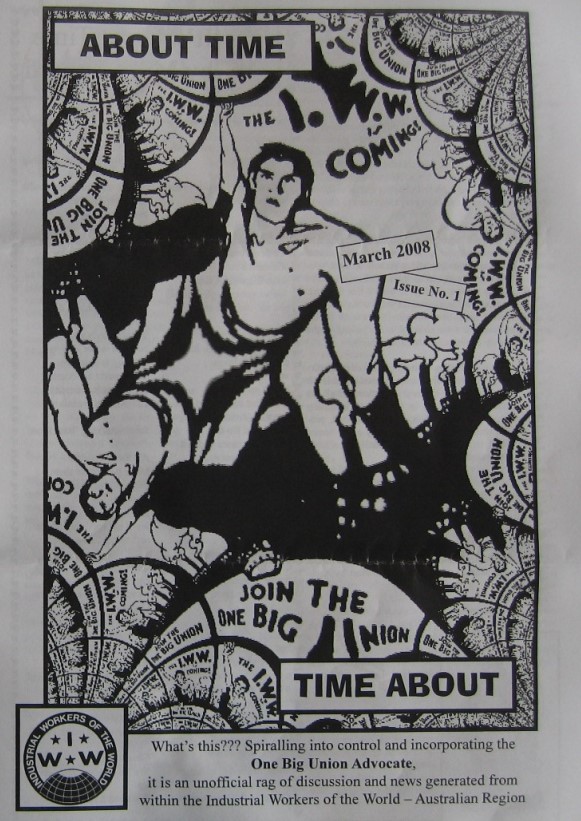Nothing beats face to face one on ones, in-person gatherings of coworkers to agitate, and meeting up with fellow workers at branch meetings, but as the pandemic continues on we are forced to reckon with the fact that we need to figure out how to use those same tactics digitally and from a safe distance. We hope today’s article is a conversation starter. The pandemic has shown us in no uncertain terms just how deadly the class divide is between the working class and the ruling class. Now, more than ever, we must organize. We must make the bosses pay and we must protect ourselves and our communities. Share this article with your branches and across social media. Let us know what you think over on our Twitter: how can we adjust our tactics to be just as effective before social distancing guidelines and working from home? What have you or your branches been doing? Have you had more or less success with these adjusted methods? We don’t know how long this pandemic will last, but we sure as hell know that normal wasn’t working and we can’t ever go back. Let’s rise from the ashes together.
These two articles (the first in an abridged format, here in its full form) appeared side by side in the March 2008 issue of ABOUT TIME, an unofficial publication of the IWW Australian Regional Organizing Committee. Find more about IWW AusROC on their website.

(Original comment from AusROC about the following article) Whatever you can do with computers and electrickery type wizardry there is no substitute for actually to (and eventually organizing) the fellow workers on the job and putting the alternative where it matters. Also, some of us have doubts that what is described below is as efficacious as the author thinks. It will obviously be easier for some fellow workers than for others. On the other hand, the IWW is not so holy. Working people have been through a bit lately and anything that can help to even the odds should be paid careful attention to.
Open-Mouth Sabotage, Networked Resistance, and Asymmetric Warfare on the Job by Kevin Carson
In an abridged form in the March 2008 issue of ABOUT TIME, we are publishing it here in full as it has been updated since it was first published with some interesting additions.
This article was first published on the P2P Foundation blog on March 15, 2008 and updated on November 4th, 2010.
A recurring theme in ruling class circles over the past thirty years has been the “crisis of governability” (e.g. Samuel Huntington, et al., The Crisis of Democracy: Report on the Governability of Democracies to the Trilateral Commission, 1975). It increased by at least an order of magnitude with the new possibilities the Internet offered for networked resistance (Netwar) by the late 1990s. David Ronfeldt and John Arquilla (The Zapatista “Social Netwar” in Mexico MR-994-A, 1998) surveyed the global support network for the Zapatista movement as one of the earliest examples of this phenomenon.
One topic that has received far less attention than it deserves, in my opinion, is the application of this networked resistance or asymmetric warfare model in the specific context of labor relations. This is the theme of draft Chapter Nine (Special Agency Problems of Labor: Internal Crisis Tendencies of the Large Organization) of my work in progress on anarchist organization theory.
As is the case with the crisis of governability in general, asymmetric warfare in the workplace predates network culture by many decades, if not centuries (it probably started the first time a slave or serf told his master some farming implement “broke itself”).
My concern here is with the specific tactic the Wobblies have called “open mouth sabotage” and the exponential increase in its potential made possible by the rise of network culture.
One of the central themes of the Cluetrain Manifesto was the potential for direct, unmediated “conversations” between workers and customers. The authors believed that by bypassing the company’s official happy talk and engaging in genuine dialogue, workers would create authentic relationships that would actually increase customer loyalty. But that’s only one side of the coin. Businesses that follow the typical MBA model of repeated and relentless downsizings and speedups, and internal authoritarianism to suppress disgruntlement over such policies, have good reason to fear their employees talking directly to the customer. Their worst nightmare scenario is for the workers to realize that the customer (or the general public) is a potential ally against their common worst enemy–management–and to pass along all the dirt to strategically chosen outsiders with the goal of causing maximum damage to the employer.
And given that the majority of corporate employers follow the same “work ’em to death and replace ’em” model of workplace relations, and that open-mouth sabotage is impossible to suppress and almost risk-free, it’s safe to assume that the coming decades will see revolutionary changes in management-labor relations as the new potential makes itself fully felt.
One of the first hints of how open-mouth sabotage might be used in the Internet age was the so-called “McLibel” case in Britain, which–although it ended in the early days of the Internet–was a humiliating PR disaster for McDonalds.
It showed itself again in 2004 with the Sinclair Media and Diebold cases (see Yochai Benkler’s account of both). Both of them showed that, in a world of bittorrent and mirror sites, it was literally impossible to suppress information once it had been made public.
Most recently, the phenomenon was demonstrated in the case of Wikileaks, where a judge’s order to disable the site
didn’t have any real impact on the availability of the Baer documents. Because Wikileaks operates sites like Wikileaks.cx in other countries, the documents remained widely available, both in the United States and abroad, and the effort to suppress access to them caused them to rocket across the Internet, drawing millions of hits on other web sites..
This was yet another demonstration of what has been facetiously labelled the “Streisand effect”: efforts to suppress embarrassing information leading to embarassment several orders of magnitude worse, from publicity attracted by the suppression attempt itself.
Meanwhile, in late 2004 and 2005, the phenomenon of “Doocing” (the firing of bloggers for negative commentary on their workplace, or for the expression of other non-approved opinions on their blogs) began to attract mainstream media attention. The interesting thing is that employers, who fired disgruntled workers out of fear for the bad publicity their blogs might attract, were blindsided by the far worse publicity–far, far worse–that resulted from news of the firing. Rather than an insular blog audience of a few hundred reading that “it sucks to work at Employer X,” or “Employer X gets away with treating its customers like shit,” it became a case of tens of millions of readers of the major newspapers of record and wire services reading that “Employer X fires blogger for revealing how bad it sucks to work at Employer X.” Again, the bosses are learning that, for the first time since the rise of the giant corporation and the broadcast culture, workers and consumers can talk back–and not only is there absolutely no way to shut us up, but we actually just keep making more and more noise the more they try to do so.
The current potential for open-mouth sabotage, and for networked anti-corporate resistance by consumers and workers, is positively breathtaking. The anonymity of the writeable web, the comparative ease with which disgruntled workers can set up anonymous sites of their own (witness the proliferation of www.employernamesucks.com sites), and the possibility of simply emailing large volumes of embarrassing information to everyone you can think of whose knowledge might be embarrassing to an employer.
All a disgruntled worker has to do is keep his eyes and ears open, write things down, and keep a copy of every potentially embarrassing document that comes his way. And just about everything is potential fodder for organizational humiliation, if you compare the official happy talk in memos and newsletters to descriptions of what management is actually doing (often in the same memos and newsletters, as a matter of fact), or if you compare the now-forgotten happy talk of six months ago (“Oceania has always been at war with Eastasia”) to what’s actually happening now. It’s pretty easy to put it all together into a single damning textfile. It’s also easy to compile a devastating email distribution list: all your employer’s major customers, contractors and outlets, the community social and charitable organizations management hobnobs with, consumer and labor advocacy groups, mainstream and alternative press at both local and national levels, etc. Just save that draft email with file attachment, pre-addressed to your distribution list, and hit “Send” the day you get fired. Or maybe just set up a dummy email account and send it anonymously right now. Either way, the subsequent barrage of emails and phone calls will hit the executive suite like an atomic blast.
In the comments to the original version of this post, a reader raised the question of whether the media would become so saturated with such attacks against thousands of targets that the individual messages would be buried in white noise. This point would be a valid criticism in regard to the general broadcast media and traditional newspapers. The good thing about network society, though, is that we’re not forced to work through broadcast media. It’s possible to “narrow-cast” open mouth sabotage to the specific audience who will be most interested in it: the major stakeholders doing business with a corporation, the community where it’s a major institution, and all the other recipients that would cause maximum embarrassment to the target.
Let’s take a specific case: Pretend you work at a hospital. You put together a textfile contrasting the deliberate understaffing and other malfeasance where you work to the official happy talk (“extraordinary patient care” “renowned for going above and beyond”) in the mission statement. You send copies to the offices of the most important doctors with admitting privileges, the local United Way/Red Cross leadership the hospital management likes to hobnob with, the Chamber of Commerce and City Council, the local nursing college that sends students to train there, the major charitable donors, the local alternative press, all the reporters whose bylines have appeared under healthcare stories in the mainstream paper, to the CEOs of other local hospitals, and then CC it to the board of directors and C-suite (not to mention major shareholders and creditors!) at corporate headquarters while you’re at it. You can probably apply the same principle pretty easily in any line of wage employment.
We’re living in an era of labor relations characterized by the convergence of two trends: the emergence of unprecedented possibilities for easy, low-cost damage to employers, at a time when workers have less reason for loyalty to their employers than at any time since the Thirteenth Amendment. In other words, the perfect storm. As more and more disgruntled workers figure out the possibilities, it will be impossible to put the genie back in the bottle.
The twentieth century was the era of the large organization. By the end of the twenty-first, there probably won’t be enough of them left to bury.
If Freedom's road seems rough and hard, And stren with rocks and thorns, Then put your wooden shoes on, pard, And you won't hurt your corns. To organize and teach, no doubt, Is very good -- that's true, But still we can't succeed without The Good Old Wooden Shoe. Joe Hill
Asymmetric Warfare on the Job #2
The Morning After
One of the things I remember many years ago now was getting a casual job cleaning an office building used by a firm a (sic) draftsmen. There were six stories to it all carpeted out with tables for plans and diagrams and filing cabinets full of files and folders and all sorts of wonderful things. Nicely carpeted as well. It seems that they had sacked a chap a few days ago. For the IWW, of course, every dismissal is an unfair dismissal and the worker is always right.
The office complex looked far from its best the morning I turned up for my dose of wage-slavery. It seems that during the night something had set off the fire extinguishers on the sixth floor and the water, following gravity’s dictates, had not really stopped percolating through the system until it could get out the front door. Nothing could ever be proved of course. Accidents happen. But to say that suspicion was in the air would be very much an understatement.
My memory of this was triggered recently because, working at a tourist accommodation place, I was told that a chap had been sacked. I did not really know him, as my cleaning shift tends to happen in the early morning before most of the toilers have their first cup of coffee, but we had exchanged nods and I thought I saw a fellow rebel. Apparently, I was told, he was caught slacking. He had been warned before and he was out. Word was sort of being passed around by management in the sort of way that suggested that they thought an example had been set that we could all profit by.
A day or two later all the systems to the water treatment to the swimming pool and the spa seemed to go awry. One of the areas the sacked slacker had made his own. Taps and valves seemed to have been turned off and on; specifications for chlorine and acidity levels were all over the place. Nobody seemed to know how to fix the problem as the other chap that usually did the job was on holiday. “It almost looks like sabotage,” I was told.
Now, this set me to wondering just how often these types of unfortunate accidents occur after a sacking or layoff. (Anyone out there got any further stories to add? ABOUT TIME would love to get more such stories).
No, after all the instinct is brutish and primitive but, let’s face it, there is something enduringly pleasant about getting even.
Now it also strikes me that with someone given the push they become the reason the focus of all suspicion. That being so perhaps others in the workforce have grudges they wouldn’t mind expressing while attention was focused in a different direction. Be careful with this one fellow workers. It is not below the police to create evidence to convict people that they “know” to be guilty. Even some that they don’t is not unknown. Anyway, I am not saying don’t do it. I am just saying think about it pretty carefully first.
Personal satisfaction in a stuff-up nicely contrived is all very well but is there any benefit to the class as a whole. Not wanting in any way to knock self-expression in this area or anything. Now, it seems to be that the answer is yes. This is for three reasons:
Firstly, as the redress many employees had through unfair dismissal laws has been taken away (and were in any case patently inadequate) the practice adds to the potential cost of sacking an employee and thus acts as a discouragement to the practice. Especially this is so because there is a random element in the potential loss involved that is difficult to calculate. And of course the more it is affected the more certain the cost, the more uncertain the amount, and the more the worry.
Secondly, it reduces the psychological effect of the sacking upon the remaining workers. Rather than feeling intimidated and totally powerless in an economic relationship it reminds us all that although the dice is definitely loaded to the bosses’ advantage, no one is helpless. We should of course respond in kind. Rather than the speed up that they expect following such an event it would be good if workers responded by working just that bit slower for a while. It is well known that unhappy workers are much less productive but it does not hurt to underline the information a bit.
Thirdly it gets members of the class acting as rebels and actors and not slaves or victims and develops initiative and courage.
As a tactic, it depends upon two important considerations.
- They must know in their hearts who is responsible.
- They must be unable to prove it.
Remember the eleventh commandment and DON’T GET CAUGHT?



